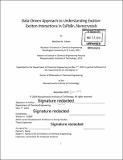Data-driven approach to understanding exciton-exciton interactions in CsPbBr₃ nanocrystals
Author(s)
Ashner, Matthew N.(Matthew Nickol)
Download1126279196-MIT.pdf (15.23Mb)
Other Contributors
Massachusetts Institute of Technology. Department of Chemical Engineering.
Advisor
William A. Tisdale.
Terms of use
Metadata
Show full item recordAbstract
Lead halide perovskites are a rapidly developing class of materials of interest for optoelectronic applications. They have a number of desirable properties such as long carrier diffusion lengths and defect tolerance that arise from the materials' unique dielectric properties. Although much of the initial interest in lead halide perovskites was geared towards producing highly efficient solar cells from the bulk material, cubic perovskite nanocrystals are a strong candidate system for light-emitting applications. Optical gain in semiconductor nanocrystals relies on emission from biexciton or doubly excited states. Knowledge of the spectral properties of biexciton states is critical for understanding optical gain development as well as many-body interactions between charge carriers more broadly. In this thesis, we develop and demonstrate a data-driven approach to characterizing the energetics and dynamics of biexciton states in CsPbBr₃ nanocrystals using TA spectroscopy. We then use the understanding developed using the TA data to guide experiments using other techniques and further examine the physical phenomena that influence these excited states. In Chapter 2, we describe our data-driven method in detail and demonstrate its effectiveness in extracting spectral information about CsPbBr₃ nanocrystals. The method combines the target analysis fit commonly employed in organic systems with Bayesian inference and a Markov chain Monte Carlo sampler to accurately characterize the model uncertainty and vet the model itself. In Chapter 3, we apply the analysis developed in Chapter 2 to a size-series of CsPbBr₃ nanocrystals to extract the biexciton and exciton component TA spectra as a function of nanocrystal size. We find that the exciton and biexciton spectra have distinctive shapes, in contrast with the common assumption about these spectra. The biexciton spectra a broader and slightly blue-shifted from the exciton spectrum, and the broadening and blue-shifting both increase as the nanocrystal size decreases. We verify this with our own time-resolved photoluminescence experiments. In Chapter 4, we propose and discuss in detail the development of an experiment to verify our hypothesis for why the exciton-exciton interaction is repulsive - the effect of polaron formation. We describe the development of a femtosecond stimulated Raman spectroscopy experiment to directly observe polaron formation and the challenges of performing this technique at high repetition rate. The central goal of this thesis is to describe a more careful approach to analyzing spectroscopic data.
Description
Thesis: Ph. D., Massachusetts Institute of Technology, Department of Chemical Engineering, 2019 Cataloged from PDF version of thesis. Includes bibliographical references (pages 105-109).
Date issued
2019Department
Massachusetts Institute of Technology. Department of Chemical EngineeringPublisher
Massachusetts Institute of Technology
Keywords
Chemical Engineering.